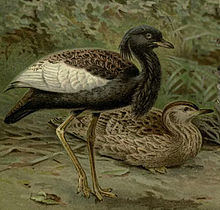Houbaropsis
| Bengal florican | |
|---|---|
 |
|
| Male (standing) and female | |
| Scientific classification | |
| Kingdom: | Animalia |
| Phylum: | Chordata |
| Class: | Aves |
| Order: | Otidiformes |
| Family: | Otididae |
| Genus: |
Houbaropsis Sharpe, 1893 |
| Species: | H. bengalensis |
| Binomial name | |
|
Houbaropsis bengalensis (Gmelin, 1789) |
|
| Synonyms | |
|
Eupodotis bengalensis (Gmelin, 1789) |
|
Eupodotis bengalensis (Gmelin, 1789)
The Bengal florican (Houbaropsis bengalensis), also called Bengal bustard, is a bustard species native to the Indian subcontinent, Cambodia and Vietnam. It is listed as Critically Endangered on the IUCN Red List because fewer than 1,500 individuals were estimated to be alive as of 2013. It is the only member of the genus Houbaropsis.
Adult Bengal floricans range from 66–68 cm (26–27 in) in length and stand around 55 cm (22 in) tall. The male has black plumage from the head and neck to underparts. Its head carries a long lanky crest, and the neck has elongated display plumes. The upperside is buff with fine black vermiculations and black arrowhead markings, and there is a conspicuous large white patch from the wing coverts to the remiges. In flight, the male's wings appear entirely white except for the dark primary remiges. The feet and legs are yellow, the bill and irides are dark.
Females are larger than the males and have a buff-brown colour similar to the males' back, with a dark brown crown and narrow dark streaks down the side of the neck. Their wing coverts are lighter than the remiges and covered in fine dark barring. Immature birds look like females. Adult females weigh around 1.7–1.9 kg (3.7–4.2 lb) against a weight of 1.2–1.5 kg (2.6–3.3 lb) in males.
They are normally silent but when disturbed utters a metallic chik-chik-chik call. Displaying males croak and produce a strange deep humming.
The only bird even remotely similar to adult males of the Bengal florican are their counterpart from the lesser florican (Sypheotides indica). This is a smaller, slimmer-necked bustard overall, and its males have cheek-tufts of plumes with pennant-like tips rather than the crest, and a white band between neck and back. The females are similar, and young Bengal floricans can be easily mistaken for female lesser floricans. The latter have almost white wing coverts however, resembling the males' wing patch.
...
Wikipedia

